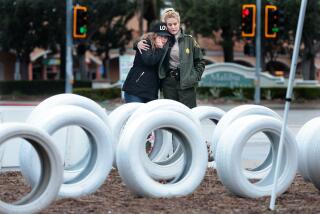Freeways Are Indeed CHP Domain, but Not Exclusively
- Share via
Dear Street Smart:
Occasionally, I notice that a city police car has pulled over another vehicle on the freeway and seems to be issuing a citation.
Also, I will see a police car at the end of an on-ramp or on the shoulder and it looks as if they are waiting for someone to do something illegal so they can write a ticket.
I was always under the impression that the CHP is “in charge” of the freeways and the city police have jurisdiction over the surface streets.
Have I been wrong all this time? If it means anything, it is usually the Irvine Police Department I see.
William A. Miller Newport Beach Not wrong at all, said Steve Kohler, a spokesman for the California Highway Patrol. The CHP does have jurisdiction over the freeway and state highway systems in California. And local police agencies do generally confine themselves to city streets.
Because the freeways travel through local jurisdictions, however, the arrangement allows for some overlap, Kohler said. If, for instance, local police officers see a traffic violation on city streets but can’t stop the driver before he gets on the freeway, they may follow him and make the stop. And officers of any law enforcement agency have the latitude to make an enforcement stop whenever or wherever they see a violation.
As for local police stationing themselves on on-ramps, what you’re seeing probably is part of a countywide plan to catch criminals trying to flee via the freeway, according to Tim Smith, a traffic sergeant with the Irvine Police Department.
“When a major crime goes down, all agencies have select points along the freeway from which to respond,” Smith said.
On average, Smith said, such contingencies are put into effect once or twice a week, usually triggered by an assault or robbery.
Dear Street Smart:
With the recent number of tragic accidents involving vans and with their tremendous popularity, especially for large families, perhaps it would be appropriate to publish some information relating to the need to increase tire sizes or inflation levels when the passenger load is increased beyond a certain point.
I would suspect that most drivers pay little or no attention to the tire load ratings in the owner manuals, and I would suspect that original-equipment tires or the same-size replacements don’t allow for much overage.
Care to comment?
Chauncey Benedict Santa Ana You might be happy to know that low tire-inflation or blowout are almost negligible causes of traffic accidents in the United States, according to Paul Snodgrass, a highway safety specialist for the National Highway Traffic Safety Administration.
“Less than 1% are caused by tires,” Snodgrass said. “Modern tires are amazingly resilient; the technology has really advanced significantly, and we haven’t seen any evidence of a link between vans and tire problems.”
Most of today’s serious accidents attributable to tires, he said, involve heavy trucks where overloading can mean a difference of several thousand pounds. In such cases, Snodgrass said, old or cheap tires combined with high temperatures and heavy overload can have disastrous effects. That’s why the federal government has funded a network of truck inspection stations along the nation’s highways where such problems can be detected.
Nonetheless, Snodgrass said, it is a good idea to check the tire pressure on your car or van every three months and certainly before any long trip involving large numbers of passengers.
“Tires lose about a pound of pressure a month just sitting there,” he said. “You should get your own tire pressure gauge and carry it with you.”
To find out your vehicle’s optimum tire pressure, he said, look on the side of the tire or check your owner’s manual, which generally recommends a slightly higher pressure for heavy loads. For most vans, though, it’s almost impossible to carry more passengers than your tires will support.
“You couldn’t cram enough people in there to do it,” Snodgrass said. “You could possibly cram enough bricks or cement blocks in there to do it, but not human beings.”
His advice: “It may sound dumb, but reading the owner’s manual is a really good idea.”
*
Street Smart appears Mondays in The Times Orange County Edition. Readers are invited to submit comments and questions about traffic, commuting and what makes it difficult to get around in Orange County. Include simple sketches if helpful. Letters may be published in upcoming columns. Please write to David Haldane, c/o Street Smart, The Times Orange County, P.O. Box 2008, Costa Mesa, CA 92626, or e-mail him at H[email protected]. Include your full name, address and day and evening phone numbers. Letters may be edited, and no anonymous letters will be accepted.
More to Read
Sign up for Essential California
The most important California stories and recommendations in your inbox every morning.
You may occasionally receive promotional content from the Los Angeles Times.










